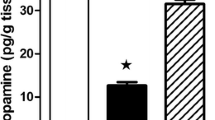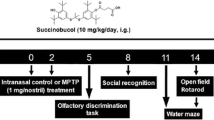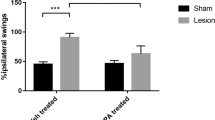Abstract
Parkinson’s disease (PD) is characterized by severe motor symptoms, and currently there is no treatment that retards disease progression or reverses damage prior to the time of clinical diagnosis. Tauroursodeoxycholic acid (TUDCA) is neuroprotective in the 1-methyl-4-phenyl-1,2,3,6-tetrahydropyridine (MPTP) mouse model of PD; however, its effect in PD motor symptoms has never been addressed. In the present work, an extensive behavior analysis was performed to better characterize the MPTP model of PD and to evaluate the effects of TUDCA in the prevention/improvement of mice phenotype. MPTP induced significant alterations in general motor performance paradigms, including increased latency in the motor swimming, adhesive removal and pole tests, as well as altered gait, foot dragging, and tremors. TUDCA administration, either before or after MPTP, significantly reduced the swimming latency, improved gait quality, and decreased foot dragging. Importantly, TUDCA was also effective in the prevention of typical parkinsonian symptoms such as spontaneous activity, ability to initiate movement and tremors. Accordingly, TUDCA prevented MPTP-induced decrease of dopaminergic fibers and ATP levels, mitochondrial dysfunction and neuroinflammation. Overall, MPTP-injected mice presented motor symptoms that are aggravated throughout time, resembling human parkinsonism, whereas PD motor symptoms were absent or mild in TUDCA-treated animals, and no aggravation was observed in any parameter. The thorough demonstration of improvement of PD symptoms together with the demonstration of the pathways triggered by TUDCA supports a subsequent clinical trial in humans and future validation of the application of this bile acid in PD.








Similar content being viewed by others
References
Hald A, Lotharius J (2005) Oxidative stress and inflammation in Parkinson’s disease: is there a causal link? Exp Neurol 193(2):279–290. https://doi.org/10.1016/j.expneurol.2005.01.013
Vila M, Ramonet D, Perier C (2008) Mitochondrial alterations in Parkinson’s disease: new clues. J Neurochem 107(2):317–328. https://doi.org/10.1111/j.1471-4159.2008.05604.x
Sofroniew MV, Vinters HV (2010) Astrocytes: biology and pathology. Acta Neuropathol 119(1):7–35. https://doi.org/10.1007/s00401-009-0619-8
Choi SS, Lee HJ, Lim I, Satoh J, Kim SU (2014) Human astrocytes: secretome profiles of cytokines and chemokines. PLoS One 9(4):e92325. https://doi.org/10.1371/journal.pone.0092325
Morizawa YM, Hirayama Y, Ohno N, Shibata S, Shigetomi E, Sui Y, Nabekura J, Sato K et al (2017) Reactive astrocytes function as phagocytes after brain ischemia via ABCA1-mediated pathway. Nat Commun 8(1):28. https://doi.org/10.1038/s41467-017-00037-1
Hirsch EC, Breidert T, Rousselet E, Hunot S, Hartmann A, Michel PP (2003) The role of glial reaction and inflammation in Parkinson’s disease. Ann N Y Acad Sci 991:214–228
Blum-Degen D, Muller T, Kuhn W, Gerlach M, Przuntek H, Riederer P (1995) Interleukin-1 beta and interleukin-6 are elevated in the cerebrospinal fluid of Alzheimer’s and de novo Parkinson’s disease patients. Neurosci Lett 202(1–2):17–20
Liddelow SA, Guttenplan KA, Clarke LE, Bennett FC, Bohlen CJ, Schirmer L, Bennett ML, Munch AE et al (2017) Neurotoxic reactive astrocytes are induced by activated microglia. Nature 541(7638):481–487. https://doi.org/10.1038/nature21029
McGeer PL, Itagaki S, Boyes BE, McGeer EG (1988) Reactive microglia are positive for HLA-DR in the substantia nigra of Parkinson’s and Alzheimer’s disease brains. Neurology 38(8):1285–1291
Miklossy J, Doudet DD, Schwab C, Yu S, McGeer EG, McGeer PL (2006) Role of ICAM-1 in persisting inflammation in Parkinson disease and MPTP monkeys. Exp Neurol 197(2):275–283. https://doi.org/10.1016/j.expneurol.2005.10.034
Mogi M, Harada M, Kondo T, Riederer P, Inagaki H, Minami M, Nagatsu T (1994) Interleukin-1 beta, interleukin-6, epidermal growth factor and transforming growth factor-alpha are elevated in the brain from parkinsonian patients. Neurosci Lett 180(2):147–150
Mogi M, Harada M, Riederer P, Narabayashi H, Fujita K, Nagatsu T (1994) Tumor necrosis factor-alpha (TNF-alpha) increases both in the brain and in the cerebrospinal fluid from parkinsonian patients. Neurosci Lett 165(1–2):208–210
Muller T, Blum-Degen D, Przuntek H, Kuhn W (1998) Interleukin-6 levels in cerebrospinal fluid inversely correlate to severity of Parkinson’s disease. Acta Neurol Scand 98(2):142–144
Blin O, Desnuelle C, Rascol O, Borg M, Peyro Saint Paul H, Azulay JP, Bille F, Figarella D et al (1994) Mitochondrial respiratory failure in skeletal muscle from patients with Parkinson’s disease and multiple system atrophy. J Neurol Sci 125(1):95–101
Mann VM, Cooper JM, Krige D, Daniel SE, Schapira AH, Marsden CD (1992) Brain, skeletal muscle and platelet homogenate mitochondrial function in Parkinson’s disease. Brain 115(Pt 2):333–342
Yoshino H, Nakagawa-Hattori Y, Kondo T, Mizuno Y (1992) Mitochondrial complex I and II activities of lymphocytes and platelets in Parkinson’s disease. J Neural Transm Park Dis Dement Sect 4(1):27–34
Chun HS, Gibson GE, DeGiorgio LA, Zhang H, Kidd VJ, Son JH (2001) Dopaminergic cell death induced by MPP(+), oxidant and specific neurotoxicants shares the common molecular mechanism. J Neurochem 76(4):1010–1021
Nicotra A, Parvez S (2002) Apoptotic molecules and MPTP-induced cell death. Neurotoxicol Teratol 24(5):599–605
Przedborski S, Vila M (2003) The 1-methyl-4-phenyl-1,2,3,6-tetrahydropyridine mouse model: a tool to explore the pathogenesis of Parkinson’s disease. Ann N Y Acad Sci 991:189–198
Heng Y, Zhang QS, Mu Z, Hu JF, Yuan YH, Chen NH (2016) Ginsenoside Rg1 attenuates motor impairment and neuroinflammation in the MPTP-probenecid-induced parkinsonism mouse model by targeting alpha-synuclein abnormalities in the substantia nigra. Toxicol Lett 243:7–21. https://doi.org/10.1016/j.toxlet.2015.12.005
Thomas B, Beal MF (2007) Parkinson’s disease. Hum Mol Genet 16(Spec 2):R183–R194. https://doi.org/10.1093/hmg/ddm159
Martin I, Dawson VL, Dawson TM (2011) Recent advances in the genetics of Parkinson’s disease. Annu Rev Genomics Hum Genet 12:301–325. https://doi.org/10.1146/annurev-genom-082410-101440
Klein C, Westenberger A (2012) Genetics of Parkinson’s disease. Cold Spring Harb Perspect Med 2(1):a008888. https://doi.org/10.1101/cshperspect.a008888
Dawson TM, Dawson VL (2014) Parkin plays a role in sporadic Parkinson’s disease. Neurodegener Dis 13(2–3):69–71. https://doi.org/10.1159/000354307
West AB, Maidment NT (2004) Genetics of parkin-linked disease. Hum Genet 114(4):327–336. https://doi.org/10.1007/s00439-003-1074-6
Shin JH, Ko HS, Kang H, Lee Y, Lee YI, Pletinkova O, Troconso JC, Dawson VL et al (2011) PARIS (ZNF746) repression of PGC-1alpha contributes to neurodegeneration in Parkinson’s disease. Cell 144(5):689–702. https://doi.org/10.1016/j.cell.2011.02.010
Duplan E, Giaime E, Viotti J, Sevalle J, Corti O, Brice A, Ariga H, Qi L et al (2013) ER-stress-associated functional link between Parkin and DJ-1 via a transcriptional cascade involving the tumor suppressor p53 and the spliced X-box binding protein XBP-1. J Cell Sci 126(Pt 9):2124–2133. https://doi.org/10.1242/jcs.127340
Marsden CD (1994) Problems with long-term levodopa therapy for Parkinson’s disease. Clin Neuropharmacol 17(Suppl 2):S32–S44
Keene CD, Rodrigues CM, Eich T, Chhabra MS, Steer CJ, Low WC (2002) Tauroursodeoxycholic acid, a bile acid, is neuroprotective in a transgenic animal model of Huntington’s disease. Proc Natl Acad Sci U S A 99(16):10671–10676. https://doi.org/10.1073/pnas.162362299
Nunes AF, Amaral JD, Lo AC, Fonseca MB, Viana RJ, Callaerts-Vegh Z, D'Hooge R, Rodrigues CM (2012) TUDCA, a bile acid, attenuates amyloid precursor protein processing and amyloid-beta deposition in APP/PS1 mice. Mol Neurobiol 45(3):440–454. https://doi.org/10.1007/s12035-012-8256-y
Rodrigues CM, Stieers CL, Keene CD, Ma X, Kren BT, Low WC, Steer CJ (2000) Tauroursodeoxycholic acid partially prevents apoptosis induced by 3-nitropropionic acid: evidence for a mitochondrial pathway independent of the permeability transition. J Neurochem 75(6):2368–2379
Ved R, Saha S, Westlund B, Perier C, Burnam L, Sluder A, Hoener M, Rodrigues CM et al (2005) Similar patterns of mitochondrial vulnerability and rescue induced by genetic modification of alpha-synuclein, parkin, and DJ-1 in Caenorhabditis elegans. J Biol Chem 280(52):42655–42668. https://doi.org/10.1074/jbc.M505910200
Castro-Caldas M, Carvalho AN, Rodrigues E, Henderson CJ, Wolf CR, Rodrigues CM, Gama MJ (2012) Tauroursodeoxycholic acid prevents MPTP-induced dopaminergic cell death in a mouse model of Parkinson’s disease. Mol Neurobiol 46(2):475–486. https://doi.org/10.1007/s12035-012-8295-4
Moreira S, Fonseca I, Nunes MJ, Rosa A, Lemos L, Rodrigues E, Carvalho AN, Outeiro TF et al (2017) Nrf2 activation by tauroursodeoxycholic acid in experimental models of Parkinson’s disease. Exp Neurol 295:77–87. https://doi.org/10.1016/j.expneurol.2017.05.009
Rosa AI, Fonseca I, Nunes MJ, Moreira S, Rodrigues E, Carvalho AN, Rodrigues CMP, Gama MJ et al (2017) Novel insights into the antioxidant role of tauroursodeoxycholic acid in experimental models of Parkinson’s disease. Biochim Biophys Acta 1863:2171–2181. https://doi.org/10.1016/j.bbadis.2017.06.004
Cunha MP, Pazini FL, Lieberknecht V, Budni J, Oliveira A, Rosa JM, Mancini G, Mazzardo L et al (2016) MPP+-lesioned mice: an experimental model of motor, emotional, memory/learning, and striatal neurochemical dysfunctions. Mol Neurobiol 54:6356–6377. https://doi.org/10.1007/s12035-016-0147-1
Rozas G, Lopez-Martin E, Guerra MJ, Labandeira-Garcia JL (1998) The overall rod performance test in the MPTP-treated-mouse model of Parkinsonism. J Neurosci Methods 83(2):165–175
Sedelis M, Hofele K, Auburger GW, Morgan S, Huston JP, Schwarting RK (2000) MPTP susceptibility in the mouse: behavioral, neurochemical, and histological analysis of gender and strain differences. Behav Genet 30(3):171–182
Guillen J (2012) FELASA guidelines and recommendations. J Am Assoc Lab Anim Sci 51(3):311–321
Nicklas W, Baneux P, Boot R, Decelle T, Deeny AA, Fumanelli M, Illgen-Wilcke B, Felasa (2002) Recommendations for the health monitoring of rodent and rabbit colonies in breeding and experimental units. Lab Anim 36 (1):20–42. doi:https://doi.org/10.1258/0023677021911740
Jackson-Lewis V, Jakowec M, Burke RE, Przedborski S (1995) Time course and morphology of dopaminergic neuronal death caused by the neurotoxin 1-methyl-4-phenyl-1,2,3,6-tetrahydropyridine. Neurodegeneration 4(3):257–269
Jackson-Lewis V, Przedborski S (2007) Protocol for the MPTP mouse model of Parkinson’s disease. Nat Protoc 2(1):141–151. https://doi.org/10.1038/nprot.2006.342
Saporito MS, Thomas BA, Scott RW (2000) MPTP activates c-Jun NH(2)-terminal kinase (JNK) and its upstream regulatory kinase MKK4 in nigrostriatal neurons in vivo. J Neurochem 75(3):1200–1208
Crosignani A, Setchell KD, Invernizzi P, Larghi A, Rodrigues CM, Podda M (1996) Clinical pharmacokinetics of therapeutic bile acids. Clin Pharmacokinet 30(5):333–358
Castro-Caldas M, Neves Carvalho A, Peixeiro I, Rodrigues E, Lechner MC, Gama MJ (2009) GSTpi expression in MPTP-induced dopaminergic neurodegeneration of C57BL/6 mouse midbrain and striatum. J Mol Neurosci 38(2):114–127. https://doi.org/10.1007/s12031-008-9141-z
Keene CD, Rodrigues CM, Eich T, Linehan-Stieers C, Abt A, Kren BT, Steer CJ, Low WC (2001) A bile acid protects against motor and cognitive deficits and reduces striatal degeneration in the 3-nitropropionic acid model of Huntington’s disease. Exp Neurol 171(2):351–360. https://doi.org/10.1006/exnr.2001.7755
Carter RJ, Lione LA, Humby T, Mangiarini L, Mahal A, Bates GP, Dunnett SB, Morton AJ (1999) Characterization of progressive motor deficits in mice transgenic for the human Huntington’s disease mutation. J Neurosci 19(8):3248–3257
Silva-Fernandes A, Duarte-Silva S, Neves-Carvalho A, Amorim M, Soares-Cunha C, Oliveira P, Thirstrup K, Teixeira-Castro A et al (2014) Chronic treatment with 17-DMAG improves balance and coordination in a new mouse model of Machado-Joseph disease. Neurotherapeutics 11(2):433–449. https://doi.org/10.1007/s13311-013-0255-9
Rogers DC, Fisher EM, Brown SD, Peters J, Hunter AJ, Martin JE (1997) Behavioral and functional analysis of mouse phenotype: SHIRPA, a proposed protocol for comprehensive phenotype assessment. Mamm Genome 8(10):711–713
Teixeira-Castro A, Jalles A, Esteves S, Kang S, da Silva Santos L, Silva-Fernandes A, Neto MF, Brielmann RM et al (2015) Serotonergic signalling suppresses ataxin 3 aggregation and neurotoxicity in animal models of Machado-Joseph disease. Brain 138(Pt 11):3221–3237. https://doi.org/10.1093/brain/awv262
Jankovic J (2008) Parkinson’s disease: clinical features and diagnosis. J Neurol Neurosurg Psychiatry 79(4):368–376. https://doi.org/10.1136/jnnp.2007.131045
Mangiarini L, Sathasivam K, Seller M, Cozens B, Harper A, Hetherington C, Lawton M, Trottier Y et al (1996) Exon 1 of the HD gene with an expanded CAG repeat is sufficient to cause a progressive neurological phenotype in transgenic mice. Cell 87(3):493–506
Hebert G, Arsaut J, Dantzer R, Demotes-Mainard J (2003) Time-course of the expression of inflammatory cytokines and matrix metalloproteinases in the striatum and mesencephalon of mice injected with 1-methyl-4-phenyl-1,2,3,6-tetrahydropyridine, a dopaminergic neurotoxin. Neurosci Lett 349(3):191–195
Pattarini R, Smeyne RJ, Morgan JI (2007) Temporal mRNA profiles of inflammatory mediators in the murine 1-methyl-4-phenyl-1,2,3,6-tetrahydropyrimidine model of Parkinson’s disease. Neuroscience 145(2):654–668. https://doi.org/10.1016/j.neuroscience.2006.12.030
Vijitruth R, Liu M, Choi DY, Nguyen XV, Hunter RL, Bing G (2006) Cyclooxygenase-2 mediates microglial activation and secondary dopaminergic cell death in the mouse MPTP model of Parkinson’s disease. J Neuroinflammation 3:6. https://doi.org/10.1186/1742-2094-3-6
Zhang Z, Huang L, Zhao W, Rigas B (2010) Annexin 1 induced by anti-inflammatory drugs binds to NF-kappaB and inhibits its activation: anticancer effects in vitro and in vivo. Cancer Res 70(6):2379–2388. https://doi.org/10.1158/0008-5472.CAN-09-4204
Schwarting RK, Sedelis M, Hofele K, Auburger GW, Huston JP (1999) Strain-dependent recovery of open-field behavior and striatal dopamine deficiency in the mouse MPTP model of Parkinson’s disease. Neurotox Res 1(1):41–56
Alexander GM, Schwartzman RJ, Grothusen JR, Brainard L, Gordon SW (1993) Changes in brain dopamine receptors in MPTP parkinsonian monkeys following L-dopa treatment. Brain Res 625(2):276–282
Fernagut PO, Diguet E, Bioulac B, Tison F (2004) MPTP potentiates 3-nitropropionic acid-induced striatal damage in mice: reference to striatonigral degeneration. Exp Neurol 185(1):47–62
Chakraborty J, Basso V, Ziviani E (2017) Post translational modification of Parkin. Biol Direct 12(1):6. https://doi.org/10.1186/s13062-017-0176-3
Xiong H, Wang D, Chen L, Choo YS, Ma H, Tang C, Xia K, Jiang W et al (2009) Parkin, PINK1, and DJ-1 form a ubiquitin E3 ligase complex promoting unfolded protein degradation. J Clin Invest 119(3):650–660. https://doi.org/10.1172/JCI37617
Hong J, Sha S, Zhou L, Wang C, Yin J, Chen L (2015) Sigma-1 receptor deficiency reduces MPTP-induced parkinsonism and death of dopaminergic neurons. Cell Death Dis 6:e1832. https://doi.org/10.1038/cddis.2015.194
Feng ZH, Wang TG, Li DD, Fung P, Wilson BC, Liu B, Ali SF, Langenbach R et al (2002) Cyclooxygenase-2-deficient mice are resistant to 1-methyl-4-phenyl1, 2, 3, 6-tetrahydropyridine-induced damage of dopaminergic neurons in the substantia nigra. Neurosci Lett 329(3):354–358
Yanguas-Casas N, Barreda-Manso MA, Nieto-Sampedro M, Romero-Ramirez L (2017) TUDCA: an agonist of the bile acid receptor GPBAR1/TGR5 with anti-inflammatory effects in microglial cells. J Cell Physiol 232(8):2231–2245. https://doi.org/10.1002/jcp.25742
Yanguas-Casas N, Barreda-Manso MA, Perez-Rial S, Nieto-Sampedro M, Romero-Ramirez L (2016) TGFbeta contributes to the anti-inflammatory effects of tauroursodeoxycholic acid on an animal model of acute neuroinflammation. Mol Neurobiol 54:6737–6749. https://doi.org/10.1007/s12035-016-0142-6
Kiani-Esfahani A, Kazemi Sheykhshabani S, Peymani M, Hashemi MS, Ghaedi K, Nasr-Esfahani MH (2016) Overexpression of annexin A1 suppresses pro-inflammatory factors in PC12 cells induced by 1-methyl-4-phenylpyridinium. Cell J 18(2):197–204
Funding
This work was supported by National funds, through the Foundation for Science and Technology (Portugal) (FCT), under the scope of the projects PTDC/NEU-NMC/0248/2012, UID/DTP/04138/2013 and POCI-01-0145-FEDER-007038, and post-doctoral grants SFRH/BPD72891/2010 (to A.I.R.), SFRH/BPD/95855/2013 (to M.J.N.), SFRH/BPD/98023/2013 (to A.N.C.), SFRH/BPD/91562/2012 (to A.S.F.) and UMINHO/BI/248/2016 (to S.D.S.). This work has also been developed under the scope of the project NORTE-01-0145-FEDER-000013, supported by the Northern Portugal Regional Operational Program (NORTE 2020), under the Portugal 2020 Partnership Agreement, through the European Regional Development Fund (FEDER), and by FEDER funds, through the Competitiveness Factors Operational Program (COMPETE).
Author information
Authors and Affiliations
Corresponding author
Ethics declarations
Conflict of Interest
The authors declare that they have no conflict of interest.
Additional information
Alexandra Isabel Rosa and Sara Duarte-Silva are joint first authors.
Electronic Supplementary Material
Supplementary Figure 1
Motor performance evaluation of animals from the preclinical trial. (a) During behavioral assessment there were no differences in body weight variation between groups. Animal performance in the (b) square (12 mm) and in the (c) round (11 mm) beam tests, in the (d) Rotarod test and (e) Stride length determination. n = 14–17 for each group used. Data are presented as mean ± SD of the different groups. p.i. – days post-MPTP injection. (PPTX 335 kb)
Supplementary Figure 2
Time to reach the cage in the pole test. In the pole test, the time the animals took to reach the cage was determined. n = 14–17 for each group used. Data are presented as mean ± SD of the different groups. p.i. – days post-MPTP injection. (PPTX 125 kb)
Supplementary Table I
(DOCX 69 kb)
Supplementary Table II
(DOCX 50 kb)
Motor swimming test. This video shows the motor swimming performance of a vehicle-treated mouse. The perspex tank was 100 cm long and the platform at the end was made from black perspex. The latency to cross the water tank was measured from a distance of 60 cm (the tank was labeled with a blue line to mark the initiation). The water temperature was monitored to 23 °C using a thermostat. (MP4 7709 kb)
Motor swimming test. This video shows the motor swimming performance of a MPTP-treated mouse. The perspex tank was 100 cm long and the platform at the end was made from black perspex. The latency to cross the water tank was measured from a distance of 60 cm (the tank was labeled with a blue line to mark the initiation). The water temperature was monitored to 23 °C using a thermostat. (MP4 7752 kb)
Motor swimming test. This video shows the motor swimming performance of a mouse treated with TUDCA before MPTP injection. The perspex tank was 100 cm long and the platform at the end was made from black perspex. The latency to cross the water tank was measured from a distance of 60 cm (the tank was labeled with a blue line to mark the initiation). The water temperature was monitored to 23 °C using a thermostat. (MP4 6226 kb)
Motor swimming test. This video shows the motor swimming performance of a mouse injected with MPTP before TUDCA treatment. The perspex tank was 100 cm long and the platform at the end was made from black perspex. The latency to cross the water tank was measured from a distance of 60 cm (the tank was labeled with a blue line to mark the initiation). The water temperature was monitored to 23 °C using a thermostat. (MP4 10,192 kb)
Rights and permissions
About this article
Cite this article
Rosa, A.I., Duarte-Silva, S., Silva-Fernandes, A. et al. Tauroursodeoxycholic Acid Improves Motor Symptoms in a Mouse Model of Parkinson’s Disease. Mol Neurobiol 55, 9139–9155 (2018). https://doi.org/10.1007/s12035-018-1062-4
Received:
Accepted:
Published:
Issue Date:
DOI: https://doi.org/10.1007/s12035-018-1062-4




